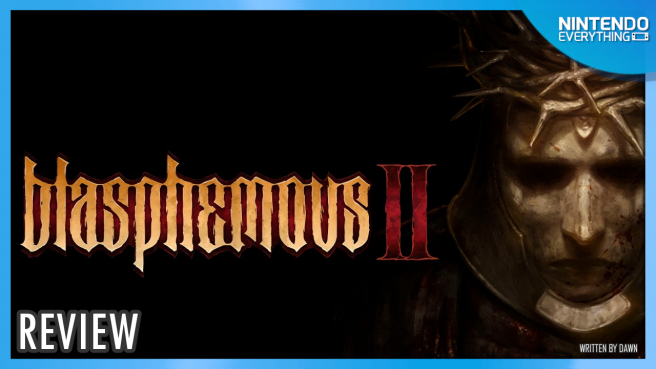System: Switch
Release date: August 24, 2023
Developer: The Game Kitchen
Publisher: Team17
Blasphemous was a smash hit when it released in 2019, two years after a highly successful Kickstarter campaign. Two years after the first game wrapped up with The Wounds of Eventide DLC, developer The Game Kitchen is back with this direct sequel. At this point you probably know if the Soulslike Metroidvania genre is one you enjoy, and Blasphemous II won’t be changing your mind. However, it stands out from the crowd and is a marked improvement on the original game, and one I would definitely recommend that you pick up if you’re on the fence.
Blasphemous II picks up where the first game’s final piece of DLC left off. The Miracle has returned to the land of Cvstodia, and a new miracle child is about to be born. The Penitent One, newly awakened from his tomb, needs to prevent this birth from occurring. This is all that you’re told at the start of the game, and unless you actively engage with the world, its numerous characters, and read every small nugget of information that the items you’ll pick up along the way have to offer you, that is all that you’re going to get. Blasphemous II is not a game that tells you a story: like everything else in the game, you have to work for it.

Building upon the narrative via hidden lore is a very common approach taken by Soulslike games, and it’s an approach that doesn’t always work. On one hand, there is something very satisfying about uncovering the hidden depths of Cvstodia for yourself, and it feels like the perfect fit for a Metroidvania title, as it adds an additional level of incentive to and reward for exploration. Everything that you do in Blasphemous II, from acquiring new prayers and miracles to speaking to NPCs and completing their sidequests, adds a new dimension to the story. The game encourages theory-crafting extreme levels, and explores religious questions and concepts in a way that invites player speculation and doesn’t necessarily provide a clear answer.
However, it is extremely easy to miss out on key pieces of information that can leave the story feeling incomplete at best and incomprehensible at worst, as it throws keywords and concepts at you with zero context, assuming you’ve discovered for yourself what it all means and can follow along. Even after replaying the first Blasphemous and then doing the majority of the sidequests in Blasphemous II I still felt as though I was missing a lot of information. Perhaps that was intentional, but if you intend to play this game for its narrative I would say this is something worth bearing in mind: to get the most out of it you will need to have that knowledge of events of the first game, and you will need to comb the world for every last scrap of information, and be prepared (if you’ll pardon the pun) to take a lot on faith. Blasphemous II is perhaps a little too cryptic for its own good sometimes, but there is a story-rich world here waiting for you to discover it if you can, and also if you choose: Blasphemous II’s deeper story is almost completely divorced from its gameplay, with that basic explanation provided at the beginning being enough to explain what you’re doing, if you’d prefer to just play the game without diving into the particulars.
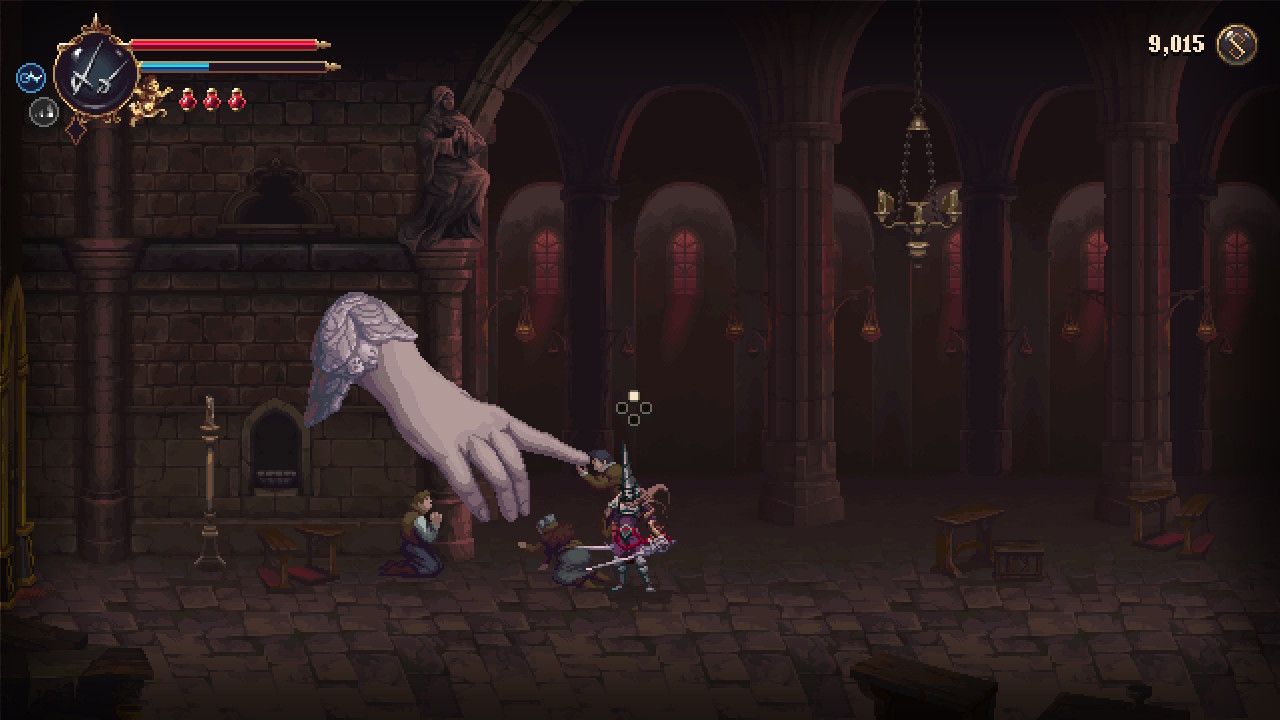
Blasphemous II, like its predecessor, is a Soulslike Metroidvania. As the Penitent One you’ll be traversing a series of fairly large interconnected areas, with progression softlocked behind defeating bosses and abilities you’ll gain as you explore. While the game will give you indicators on the map of where you need to go next to advance the story, it doesn’t tell you how to get there, and of course the path is very rarely a straight line, and you’ll often have to backtrack into areas to acquire new abilities to proceed. Whereas Blasphemous leaned more towards being a Soulslike, with a greater emphasis on tough boss battles and repeated death, its sequel leans more towards the Metroidvania side of things with platforming, exploration, and a slightly more forgiving (for the most part) level of difficulty being the focus of the gameplay.
The level design in Blasphemous II is fantastic, with less of a reliance on infuriating bottomless pits and spike traps (which now only cleave off a chunk of health and teleport you back to where you fell off rather than killing you outright, a welcome change from the original) to impede your progress and a greater emphasis on platforming and puzzle-solving, utilizing your abilities to make it through the obstacles presented to you. Controls are notably tighter and more responsive, which made controlling the Penitent One extremely satisfying. There is a level of precision in every movement that makes pulling off difficult jumps, or defeating bosses, feel like a mark of skill and achievement, and makes failure far less frustrating.
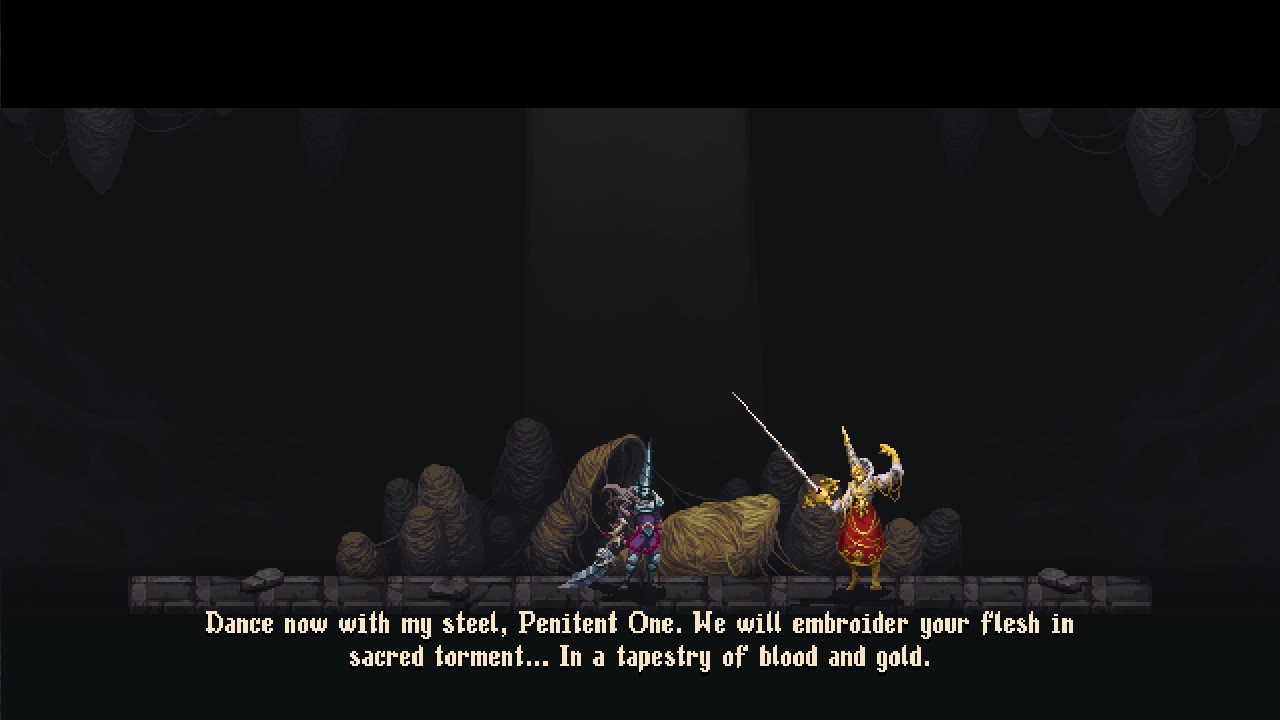
There are still Soulslike gameplay mechanics present in Blasphemous II, which are a little more punishing than is standard for the genre: each time you die you will build up Guilt, which locks away part of your Fervour bar, the game’s magic meter. Returning to where you died will restore this, but only up to a point: if you die too many times, you’ll need to either defeat a boss enemy or pay one of the game’s NPCs in the city to restore it. The fast travel portals are conveniently located next to a Prie Dieu save point most of the time, meaning this is more of a minor inconvenience than it is an excessive source of frustration, as it is likely that most of your deaths will be around bosses (that was where I found myself dying most often at least!) but it is one small way in which the game is notably more punishing than its peers.
You’re initially given a choice of one of three weapons, which has a profound effect on the early game, as each one has a use outside of combat that will affect which areas you can access. Choosing the Veredicto, a slow but powerful mace-like weapon, will allow you to ring bells, letting you activate platforms and break through certain doors. The Ruego Al Alba, a sword similar to the Mea Culpa from the first game, can break through barriers, and the dual blades, Sarmiento and Centella, let you jump between mirrors. You’ll eventually acquire the other two weapons as you progress, but you will encounter obstacles that need these weapon abilities to progress from the beginning of the game, and it encourages backtracking and observation in a very organic way: more than once I found myself placing map markers to remind myself of where things were placed, so I could return later once I’d found the weapon. It’s unfortunate that they didn’t take this further and change the sequence of events and bosses you face based on your choice of starting weapon, but it made the mandatory backtracking feel far less tedious than it otherwise could have, and encouraged me to pay more attention to my surroundings than I otherwise may have.
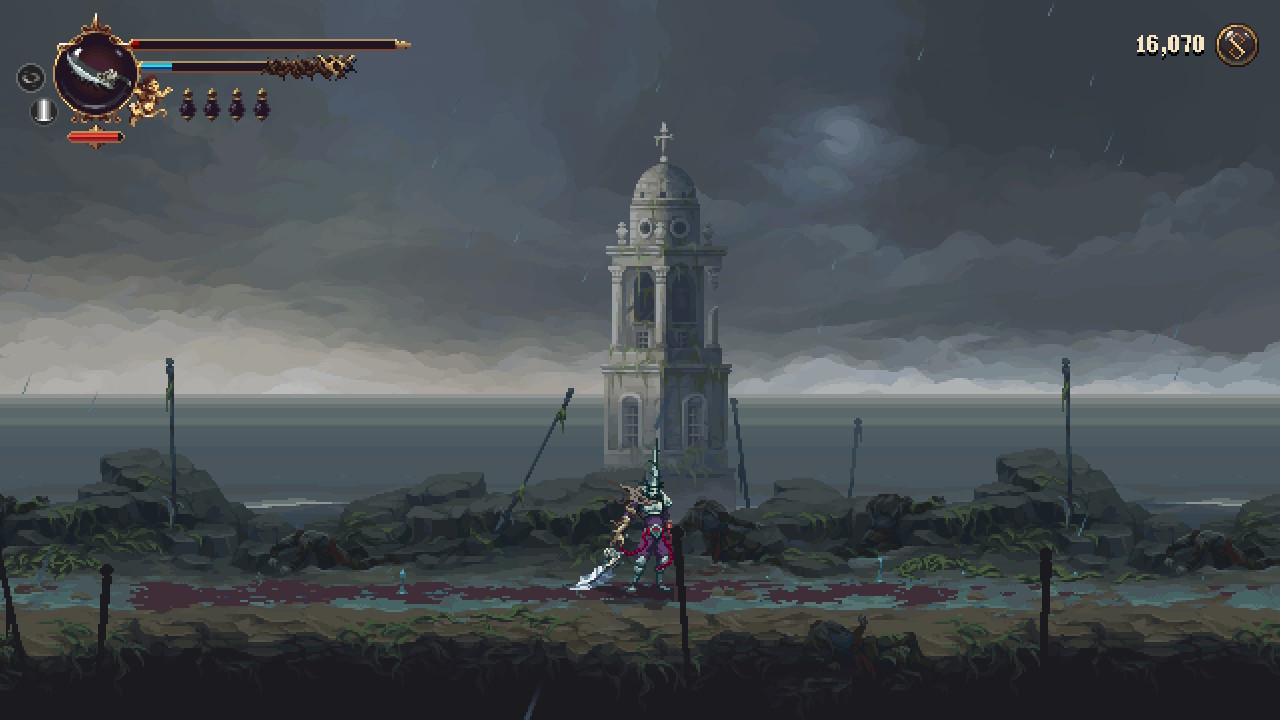
This also affects the game’s combat, making it feel like a more strategic affair, and less reliant on learning boss’ attack patterns to perfection. This is not to say that Blasphemous II is an easier experience necessarily, but having additional options in combat makes defeat far less frustrating: if you’re having trouble lasting against one boss long enough to kill it with the Ruego Al Alba, you might have more luck with the Veredicto, which is slower but hits harder. Some bosses are clearly designed to be fought with specific weapons, but there is no requirement to use one over another. Each weapon can also be upgraded with Marks of Martyrdom, skill points you’ll find during exploration and be awarded with for defeating enemies. This opens up the possibility of character builds, as you will need to be selective about where you choose to assign these.
However, there are some undeniably frustrating difficulty spikes in Blasphemous II that throw off the overall pace of the game. The third boss stands out in particular in my mind as distinctly unfair, being the only boss that has you fight more than one enemy at a time with separate health bars, and also has three phases on top of that. At such an early stage in the game it feels out of place when the bosses that follow it feel more like a test of your skill rather than your patience, and aren’t a tiring war of attrition. The game is also extremely fond of locking you into small rooms and throwing waves of enemies at you, to the point that it becomes very repetitive in some late game areas where you can’t go through a couple of rooms without having the exits blocked yet again until you clear three or four waves of enemies you’ve been encountering in every other room prior to that.
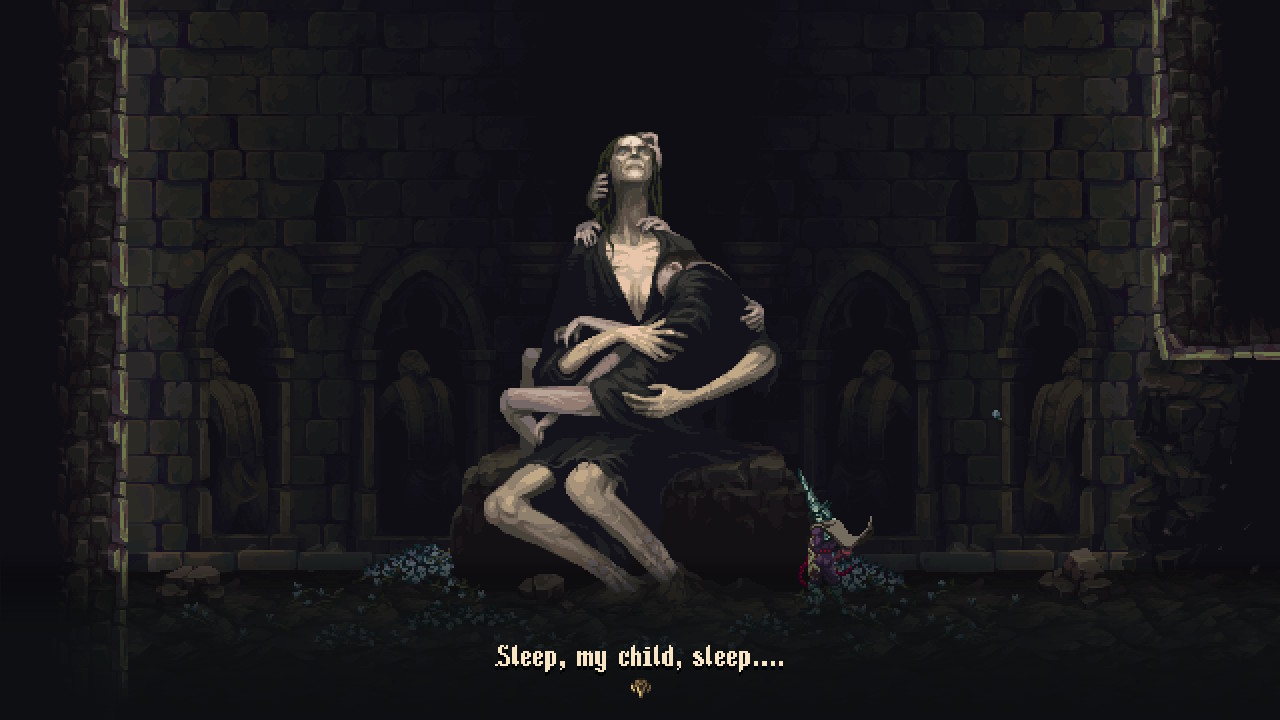
While the level design of Blasphemous II is excellent, as time wore on I couldn’t help but feel as though it was running out of tricks, as for most of it you’ll be doing the same thing over and over, and outside of the boss encounters the difficulty of the game didn’t increase so much as it did require you to do the exact same thing you had been doing since the beginning – ringing bells, jumping between mirrors, or finding a way to get high enough to slam through a barrier – just more frequently, or in a slightly different order. Doing this remained consistently satisfying, but it was never particularly difficult to figure out what I needed to do or how to do it, and the unfortunate disadvantage to having so many options for combat is that most enemy encounters were relatively simple, with the difficulty coming more from the high amount of damage they inflicted rather than from exploiting weaknesses.
Blasphemous II has an excellent world design and artistic direction, steeped heavily in religious imagery, and the pixel art conveys a high level of detail and animation, with some truly disturbing bosses and NPCs being particular highlights. Cutscenes have received a noticeable upgrade and I would have liked to have seen more of these in the game, as they are unfortunately very scarce and generally reserved only for major story moments. The ambient soundtrack is mostly unobtrusive but each area has its own distinct theme that helps to generate a unique atmosphere, and what little voice acting there is is of a good quality. I found myself paying more attention to the sound effects than I did the soundtrack, with meaty hits from the Veredicto being especially satisfying, as well as the echoing clash of steel from a successfully executed parry, giving an added level of feedback that made using these weapons in combat more satisfying than they otherwise might have been.
The Verdict

Blasphemous II is a well-crafted experience that improves upon the original title in every way, and stands out amongst the crowd for its fantastic visual design, rich lore, and excellent gameplay. It doesn’t redefine the genre in any noteworthy way, and the difficulty is not an entirely even curve, but it is nonetheless a solid entry for the genre and a worthy successor. If you enjoyed the first Blasphemous or similar titles this is a game I would highly recommend checking out, and if you’ve never played a Soulslike Metroidvania before and aren’t particular about needing to understand the story, you could do worse than making this your first one.
